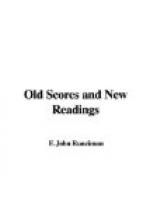Waking on the morrow of the “John” performance, my memory was principally filled with those hoarse, stormy, passionate roarings of an enraged mob. A careless reckoning shows that whereas the people’s choruses in the “Matthew” Passion occupy about ninety bars, in the “John” they fill about two hundred and fifty. “Barabbas” in the “Matthew” is a single yell; in the “John” it takes up four bars. “Let Him be crucified” in the “Matthew” is eighteen bars long, counting the repetition, while “Crucify” and “Away with Him” in the “John” amount to fifty bars. Moreover, the people’s choruses are written in a much more violent and tempestuous style in the earlier than in the later setting. In the “Matthew” there is nothing like those terrific ascending and descending chromatic passages in “Waere dieser nicht ein Ubelthaeter” and “Wir duerfen Niemand toeden,” or the short breathless shouts near the finish of the former chorus, as though the infuriated rabble had nearly exhausted itself, or, again, the excited chattering of the soldiers when they get Christ’s coat, “Lasst uns den nicht zertheilen.” Considering these things, one sees that the first impression the “John” Passion gives is the true impression, and that Bach had deliberately set out to depict the preliminary scenes of the crucifixion with greater fulness of detail and in more striking colours than he afterwards attempted in the “Matthew” Passion. Then, not only is the physical suffering of Christ insisted on in this way, but the chorales, recitatives, and songs lay still greater stress upon it, either directly, by actual description, or indirectly, by




